Easy Jumping Spider Types to Keep as Pets
Whether you already own exotic pets or want to begin, jumping spiders are an excellent option. Although they are spiders, and hairy ones at that, jumping spiders have become known as the cutest arachnid around. With their huge eyes that are reminiscent of a puppy’s and fluffy eyelashes, these little creatures make up the Salticidae family of spiders; with over 4,000 known species, they are actually the largest family of spiders.
Some people often mistake jumping spiders for insects, instead of arachnids. This definitely isn’t the case. The main difference between insects and spiders is the number of body parts each has; insects have three body parts while spiders have two. There is also the difference in the number of legs each has, with spiders having eight legs and insects usually only sporting six. And, of course, most insects have the ability to crawl while jumping spiders – you guessed it! – jump.
This ability to jump is the primary hunting method for jumping spiders. They do not use webs like most traditional spiders; instead, jumping spiders will stalk their prey before leaping to attack. Because of this, these spiders are often very entertaining to watch when kept as pets.
Jumping spiders, which have affectionately been nicknamed jumpers, have increased in popularity recently; this might be due to their trendiness online, like on TikTok and other social media platforms, or their low maintenance care requirements as pets. Not only are they adorable, but these spiders are easy to look after if kept in the right conditions.
So, what should you look for when choosing a pet jumping spider? For beginners in the arachnid world, finding a species that has simple requirements, such as feeding and housing, should be the aim. Thankfully, several jumping spider species listed below are easy to care for.
Types of Jumping Spiders:
As mentioned previously, there are numerous species of jumping spiders; some of them have more elaborate care needs than others. The eight species mentioned in this article are considered to be some of the easiest jumpers to keep as pets.
For each species mentioned, some of the positives and negatives will be mentioned to ensure beginners make the most informed decision when selecting their arachnid companion.
Regal Jumping Spider (Phidippus Regius)
Also known as the phidippus regius, regal jumping spiders are one of the most popular species to be kept as pets. This stems from how easy it is to keep them as pets successfully. They are also quite large in comparison to other jumping spiders and the females have beautiful colors, making them a great option to look at and observe. Males, however, often mature to be black and white, which can cause trouble identifying them as regals instead of bold jumping spiders.
The regal jumping spider is usually found in the United States and Mexico and comes in a variety of colors, depending on their geographical location. This species is also very active and can be seen jumping around during the day, and even in the evening. Regal jumping spiders eat a variety of prey and can be easily fed with crickets, flies, and other insects.
The only downside to this species is that they can be quite skittish and can be easily startled; this means that they might not enjoy being handled. However, there are steps that can be followed to make the handling process easier.
To find out more about regal jumping spiders, click here.
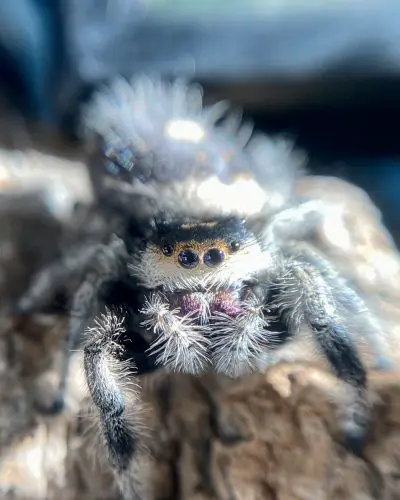
Bold Jumping Spider (Phidippus Audax)
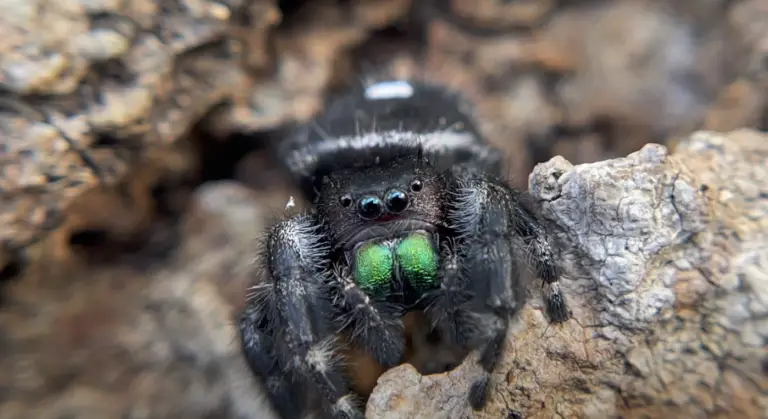
Commonly found in North America, the bold jumping spider is another popular species to keep as a pet. They are considered to be one of the most docile species of jumping spiders and can be quite easy to handle, due to their daring – or bold – nature.
Bold jumping spiders are also quite large, making them easier to observe, and are mostly black and white. They can also be quite active and jump around quite a lot, especially during the day.
This species can be quite hardy and can be kept in a variety of conditions, as long as they are kept warm. They also eat a range of prey, such as crickets and flies, and can survive on a diet of fruit flies if needed.
As juvenile spiders, most jumpers, including bold jumping spiders, will hunt smaller insects, such as flightless fruit flies or small crickets. Targeting smaller prey ensures the jumping spider is not injured during the hunt or feeding.
Tan Jumping Spider (Platycryptus Undatus)
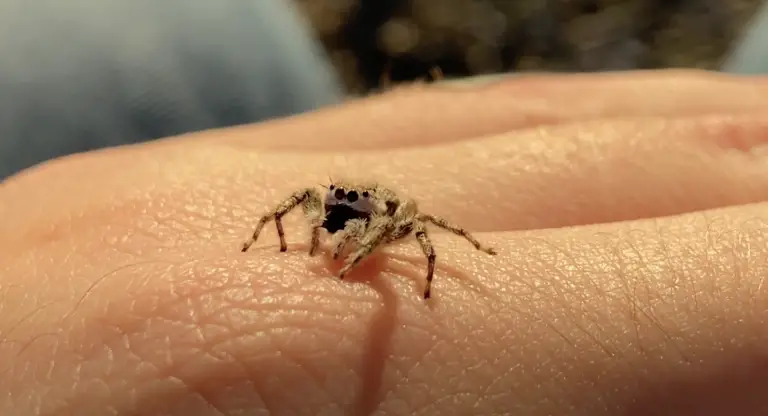
Another option for pet jumping spiders is the tan jumper. This species can be found around the United States and Canada, mainly hiding out in narrow crevices of tree bark.
Tan jumping spiders are quite small in size and can be quite hard to observe, especially as their coloring causes them to blend in with their surrounding habitat. Unsurprisingly, as their name would suggest, this spider is primarily tan with an orange pattern on its abdomen.
Like most other jumping spiders which are kept as pets, the tan jumping spider will bite if it feels threatened. These cute spiders are usually quite happy to be handled gently, so keep a light touch and allow the spider to jump or crawl onto your hand instead of trying to pick it up.
Heavy Jumping Spider (Hyllus Diardi)
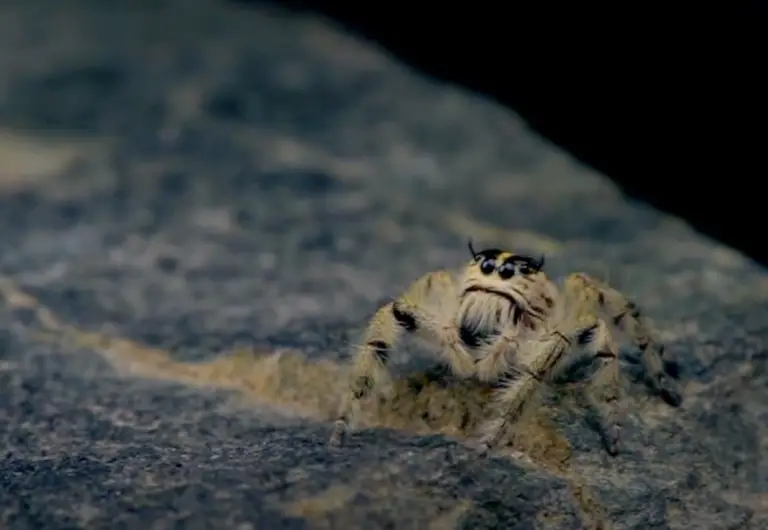
The heavy jumper is one of the larger species of jumping spider. Even with their impressive size, heaving jumping spiders, also called giant jumping spiders, hunt with precision. They are well-known for leaping onto their prey, landing with such a heavy impact that their nickname was born – the heavy jumping spider.
These spiders are usually found in India, Southeast Asia, and Australia. Upon maturity, most spiders of this species will be grayish-white in color. Not only are they known for their size, but these spiders also have long, flicking eyelashes; this is why some people know these spiders as eyelash jumping spiders.
In terms of care, the heavy jumping spider is fairly easy to take care of. They can be easily fed with crickets, flies, and other insects.
Zebra Jumping Spider (Salticus Scenicus)
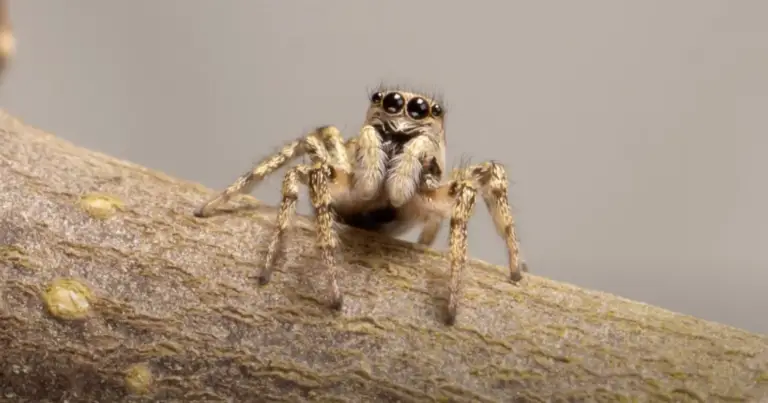
As one of the smaller jumping spiders, the zebra jumping spider can be slightly more fiddly to care for. Their small size means it is a lot easier for them to escape from their enclosure and get lost.
The zebra jumping spider is usually found in Europe, North America, and Asia, and they come in a variety of colors, with the most common one being black and white. Zebra jumping spiders can be easily fed with small insects, such as pinhead crickets, flies, and mini mealworms; this makes them one of the easiest jumping spider pets to care for.
Elegant Golden Jumping Spider (Chrysilla Lauta)
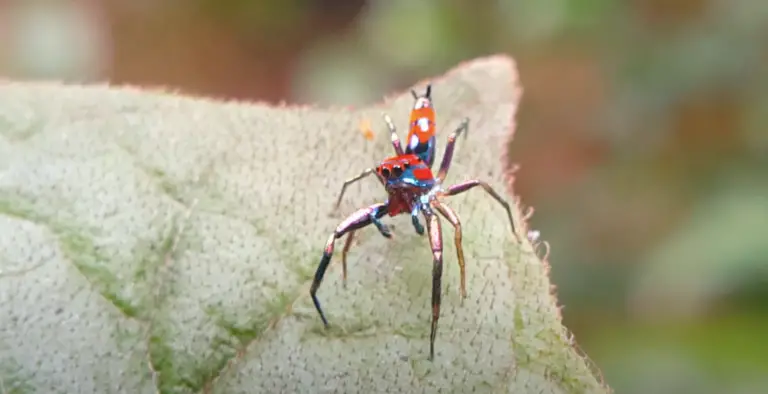
With a natural habitat of rainforests in Asian countries, elegant golden jumping spiders have been introduced to the US and Europe. This is likely due to their exotic appearance making them highly sought-after; they are primarily a golden bronze color, but they can develop various shades of blue, red, and yellow.
The males of this species are relatively easy to spot, too, and not just for their coloring. They are slim spiders, which is quite rare in comparison to other species’ chunky appearances.
As adult spiders in the wild, the elegant golden jumping spider species can take on larger insects, such as crickets and grasshoppers. Therefore, these can be food options for a pet jumping spider, too.
Shiny Jumping Spider (Cosmophasis Umbratica)
Shiny jumping spiders are very unique; when viewed under UV, they can reflect the UV light from almost their entire body, depending on their sex. This is known as extreme dimorphism; males show UV on all body parts while juvenile spiders and females don’t show any at all. It is believed this is essential for mating.
Again, similar to the elegant golden jumping spider, shiny jumpers are popular due to their appearance. Males have an iridescent coloration and are slightly bigger than the females of the species, which is rather uncommon as females tend to be the larger sex.
Another rare aspect of these spiders is their fondness for consuming nectar, making them nectarivorous.
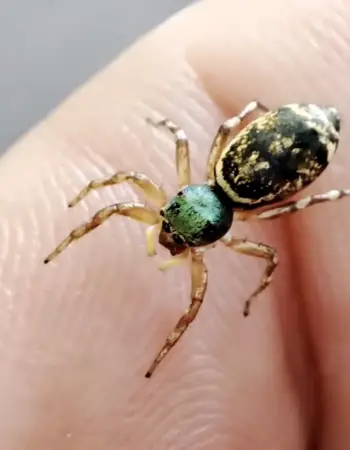
White-Mustached Jumping Spider (Portia Labiata)
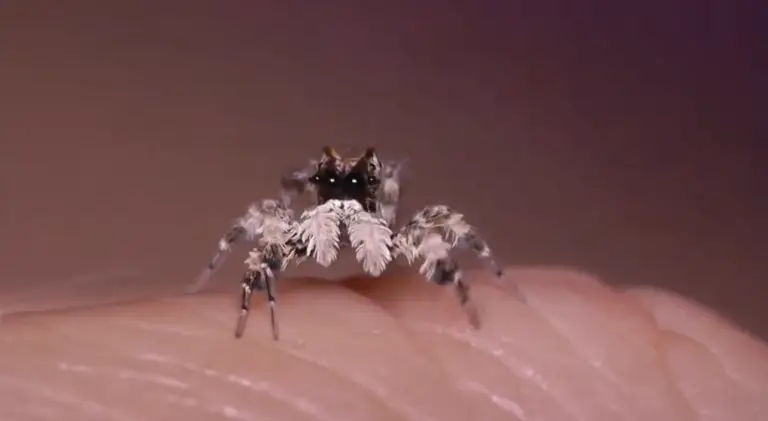
Aptly named, the white-mustached jumping spider has a distinctive appearance with two fangs seemingly coated in white hair, which looks like a thick mustache.
This species is usually found in India, China, and Australia and is known to have the most complex cognitive abilities of all jumping spiders. This is due to their ability to problem solve and use tools, such as leaves, to their advantage; watch this YouTube video to them in action.
White-mustached jumping spiders tend to be more active at night and will consume a range of food, such as flies and crickets. They have also been found hunting other jumping spiders in the wild.
Jumping spider pets are an excellent option for those wishing to add an arachnid to their family. With their adorable appearance and relatively easy care requirements, these spiders make great companions.
The eight jumping spider species mentioned in this article are some of the easiest jumpers to keep as pets. Each species has its needs, so it is important to research each one to ensure you get the best pet.
